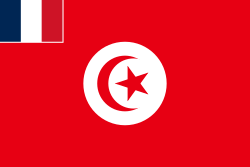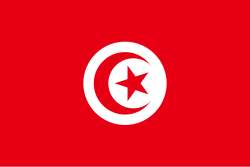| Flag | Date | Use | Description |
|---|
 | 1229–1337 | Flag of The Hafsid Sultanate of Tunis | A red field with a white crescent moon in the center and 3 sestiere on the fly. |
 | 1424–1550 | A yellow field with a white crescent moon and a 5–pointed star in the center. |
 | 1550–1574 | A white field with a blue crescent moon in the center and a vertical blue stripe off–centered toward the hoist. |
 | 1574–1705 | Flag of the Eyalet of Tunis | A red field with 3 golden crescent moons off–centered towards the hoist. |
 | 1705–1827 | Flag of the Beylik of Tunis | A 5 horizontal striped banner with 2 blue strip, 2 red and 1 green. The right edge of the flag is partially scalloped. |
 | 1827–1881 | A red field with a centered white sun–disc containing a red five–pointed star surrounded by a red crescent. |
 | 1827–1881 | Monarchic Flag of the Beylik of Tunis | A 7 horizontal striped banner with 4 red strips, 2 golden and 1 green with 31 6–pointed stars, 24 discs and a 2 pointed sword in the center. |
 | 1881–1885 | Unofficial flag of the French protectorate of Tunisia | A red field with a centered white sun–disc containing a red five–pointed star surrounded by a red crescent with the French tricolour in the canton. |
 | 1885–1956 | Flag of the French protectorate of Tunisia | A red field with a centered white sun–disc containing a red five–pointed star surrounded by a red crescent. |
 | 1956–1957 | Flag of the Kingdom of Tunisia | A red field with a centered white sun–disc containing a red five–pointed star surrounded by a red crescent. |
 | 1957–1959 | Flag of the Republic of Tunisia | A red field with a centered white sun–disc containing a red five–pointed star surrounded by a red crescent. |
 | 1959–1999 | Flag of the Republic of Tunisia | A red field with a centered white sun–disc containing a red five–pointed star surrounded by a red crescent. |
















